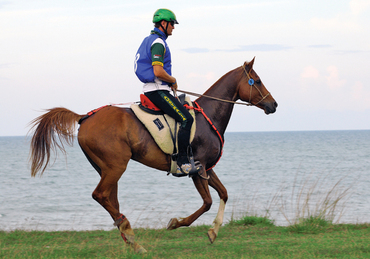CHAPTER 22 Endurance is one of the fastest growing equestrian sports in the world and is a competition of distance and speed. Riders must manage the horses appropriately in variable conditions and terrain to cover the set distance in the shortest time with a healthy, fit horse on completion. Ride distances range from 40 to 160 kilometers (km) in one day, as well as multiday marathon rides. Stringent rules and regulations govern the organization of the rides and the monitoring of the horses to ensure that the welfare of the animals is protected. Riders of all ages participate in endurance races, at all levels from social and training rides through to championship rides. Participation ranges from riders with one horse taking part in local competitions as a recreation through to professional trainers, riders, and stables competing for world rankings, with breeding, sale, and training of elite horses conducted as a business. Competing in endurance is, by definition, a long-term aim because it takes several years to prepare a horse to travel at competitive speeds over long distances, particularly as the welfare of the horse is always the paramount concern (Figure 22-1). Getting to know each horse and monitoring its progress are critical factors in training. Although generalizations can be made, each horse needs to be treated as an individual and particular attention should be paid to any problems that may develop, such as back pain, girth rubs, lameness and leg injuries, or mouth rubs from the bit. It is important to ensure that the animal receives appropriate care of hooves because of the impact of hoof function on other aspects of musculoskeletal function. Routine dental care is also essential for optimal performance. Some competition organizers now allow horses to compete unshod. If this is intended, conditioning and care for barefoot riding should commence at the outset of training. If any problems do develop, especially in the early stages of training, work should be stopped while the problem is properly identified and rectified; this may mean that the horse requires further rest until the issue is resolved. Endurance exercise is primarily aerobic and appropriate training will enhance the natural aerobic capacity of muscles (D’Angelis et al., 2005; Essen-Gustavsson et al., 1989; Serrano et al., 2000). Thus, the initial training for the distance mentioned above is also well suited to improve the overall aerobic capacity of muscles (see Chapter 12), as well as associated cardiovascular and respiratory system adaptations. Such exercise will strengthen ligaments, tendons, and bones, as this base of strength is very important before fast, more intense work is attempted. There will be gradual remodeling of bones and strengthening of tendons and ligaments in response to this conditioning and it is important not to hasten this process. Rest time is critical while the remodeling occurs (see also Chapter 13). If the horse appears listless and tired or demonstrates any signs such as swelling or filling in the legs the day after any training session, it is advisable to reduce the training session or give the horse a rest day, to give the musculoskeletal system time to strengthen and adapt to the stresses being progressively applied.
Training endurance horses
Training for distance
Training the musculoskeletal system
< div class='tao-gold-member'>
Training endurance horses
Only gold members can continue reading. Log In or Register to continue

Full access? Get Clinical Tree



